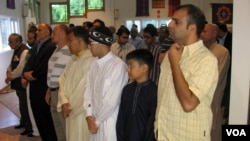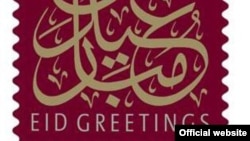As the Muslim holy month of Ramadan drew to a close, Muslim-Americans of diverse backgrounds and national origins gathered in mosques and Islamic centers across the United States to celebrate Eid al-Fitr, or "fast breaking" holiday.
While prayers mark the beginning of the celebration, Eid breakfast is an important meal for practicing Muslims, who had been fasting from sunrise to sunset for an entire month.
During Eid al-Fitr, Muslims around the world celebrate by performing special prayers, paying social visits and seeking to strengthen family and community bonds.
Eid prayers in the U.S. are usually held either in local mosques or in public facilities designed to accommodate large gatherings. Esam Omeish led the prayers at a ballroom at a hotel in the northern part of the U.S. state of Virginia.
“Eid prayers here are attended by Muslims from more than 40 different backgrounds and national origins. That much diversity does not exist elsewhere except during the Muslim pilgrimage to Mecca,” said Omeish.
Participants exchange embraces at the conclusion of the prayers.
Imam Hassan Qazwini, President of the Islamic Center of America in Dearborn, Michgan, says his center has to offer consecutive Eid prayers to accommodate the thousands of Muslim participants.
“We perform Eid prayers five times because in such a holy occasion we have more than 7000 worshippers celebrating the end of Ramadan at the center,” said the imam.
As with most holidays, Eid is a special day for children. They receive gifts or money from their parents, wear new outfits and enjoy their time with their families and friends.
Aziza Khan, a mother of two, attended with her children.
“We put on our best clothes,” said Khan. “Everyone comes dressed up. All the kids are excited, and they love showing off their new outfits. It’s just a sea of gorgeous colors.”
American Muslims do not celebrate Eid the same way people in predominantly Muslim countries do. In the U.S., many Muslims might still have to attend to their daily business during Eid.
Omar Okaily attended the early Eid prayers so that he could go back to his office.
“While we are enjoying our religious freedom in the U.S., our Islamic religious occasions are not official holidays,” said Okaily.
American Muslims mark the end of Ramadan also with charitable contributions to the needy and by helping less fortunate Muslims “taste” the joy of this Islamic holiday. Imam Shaker Elsayed of Dar Alhijra Islamic Center in Northern Virginia explained.
“Before Eid celebrations, we collect ten dollars from each fasting Muslim to buy food and new clothes for poor Muslims in the community,” said Elsayed.
For Muslim-American groups, every year Eid brings an opportunity to educate the American public about the religious observance and the Islamic faith in general. Nihad Awad, the executive director of the Washington-based Council on American-Islamic Relations says, "The Council sends out information relating to Eid to our non-Muslim constituency and friends.” The mailing, he says, is intended to serve as a reminder for all Americans that Muslims are an integral part of U.S. society.
Official Eid greetings
Since 1992, U.S. presidents have issued Eid greetings each year to the more than 1.2 billion Muslims worldwide. President Obama congratulated Muslim Americans and Muslims around the world on this joyous day on behalf of the American people.
“Michelle and I send our warmest greetings to Muslims celebrating Eid al-Fitr here in the United States and around the world,” the president said in a statement. “For millions of Americans, Eid is part of a great tapestry of America’s many traditions, and I wish all Muslims a blessed and joyful celebration. Eid Mubarak.”
Imam Abdulla Khouj, president of the Islamic Center in Washington, D.C., believes the Ramadan and Eid greetings offered by consecutive American presidents since early 1990s have helped raise awareness about Islam among Americans.
"When the president of a great country acknowledges the fact that people are fasting and somehow shares with them their feelings, that makes them feel that they are welcome in this country," Imam Khouj said.
For Sami Elenazi, a new resident originally from Saudi Arabia, the greeting had symbolic value.
“This presidential tradition is the best proof of religious tolerance in the U.S.,” Elenazi said. “Although I am a newcomer to this country, I felt at home celebrating the end of Ramadan.”
Since 2001, U.S. Postal Service has been marking Eid by issuing a special stamp with traditional Islamic greetings in Arabic.
While prayers mark the beginning of the celebration, Eid breakfast is an important meal for practicing Muslims, who had been fasting from sunrise to sunset for an entire month.
During Eid al-Fitr, Muslims around the world celebrate by performing special prayers, paying social visits and seeking to strengthen family and community bonds.
Eid prayers in the U.S. are usually held either in local mosques or in public facilities designed to accommodate large gatherings. Esam Omeish led the prayers at a ballroom at a hotel in the northern part of the U.S. state of Virginia.
“Eid prayers here are attended by Muslims from more than 40 different backgrounds and national origins. That much diversity does not exist elsewhere except during the Muslim pilgrimage to Mecca,” said Omeish.
Participants exchange embraces at the conclusion of the prayers.
Imam Hassan Qazwini, President of the Islamic Center of America in Dearborn, Michgan, says his center has to offer consecutive Eid prayers to accommodate the thousands of Muslim participants.
“We perform Eid prayers five times because in such a holy occasion we have more than 7000 worshippers celebrating the end of Ramadan at the center,” said the imam.
As with most holidays, Eid is a special day for children. They receive gifts or money from their parents, wear new outfits and enjoy their time with their families and friends.
Aziza Khan, a mother of two, attended with her children.
“We put on our best clothes,” said Khan. “Everyone comes dressed up. All the kids are excited, and they love showing off their new outfits. It’s just a sea of gorgeous colors.”
American Muslims do not celebrate Eid the same way people in predominantly Muslim countries do. In the U.S., many Muslims might still have to attend to their daily business during Eid.
Omar Okaily attended the early Eid prayers so that he could go back to his office.
“While we are enjoying our religious freedom in the U.S., our Islamic religious occasions are not official holidays,” said Okaily.
American Muslims mark the end of Ramadan also with charitable contributions to the needy and by helping less fortunate Muslims “taste” the joy of this Islamic holiday. Imam Shaker Elsayed of Dar Alhijra Islamic Center in Northern Virginia explained.
“Before Eid celebrations, we collect ten dollars from each fasting Muslim to buy food and new clothes for poor Muslims in the community,” said Elsayed.
For Muslim-American groups, every year Eid brings an opportunity to educate the American public about the religious observance and the Islamic faith in general. Nihad Awad, the executive director of the Washington-based Council on American-Islamic Relations says, "The Council sends out information relating to Eid to our non-Muslim constituency and friends.” The mailing, he says, is intended to serve as a reminder for all Americans that Muslims are an integral part of U.S. society.
Official Eid greetings
Since 1992, U.S. presidents have issued Eid greetings each year to the more than 1.2 billion Muslims worldwide. President Obama congratulated Muslim Americans and Muslims around the world on this joyous day on behalf of the American people.
“Michelle and I send our warmest greetings to Muslims celebrating Eid al-Fitr here in the United States and around the world,” the president said in a statement. “For millions of Americans, Eid is part of a great tapestry of America’s many traditions, and I wish all Muslims a blessed and joyful celebration. Eid Mubarak.”
Imam Abdulla Khouj, president of the Islamic Center in Washington, D.C., believes the Ramadan and Eid greetings offered by consecutive American presidents since early 1990s have helped raise awareness about Islam among Americans.
"When the president of a great country acknowledges the fact that people are fasting and somehow shares with them their feelings, that makes them feel that they are welcome in this country," Imam Khouj said.
For Sami Elenazi, a new resident originally from Saudi Arabia, the greeting had symbolic value.
“This presidential tradition is the best proof of religious tolerance in the U.S.,” Elenazi said. “Although I am a newcomer to this country, I felt at home celebrating the end of Ramadan.”
Since 2001, U.S. Postal Service has been marking Eid by issuing a special stamp with traditional Islamic greetings in Arabic.









